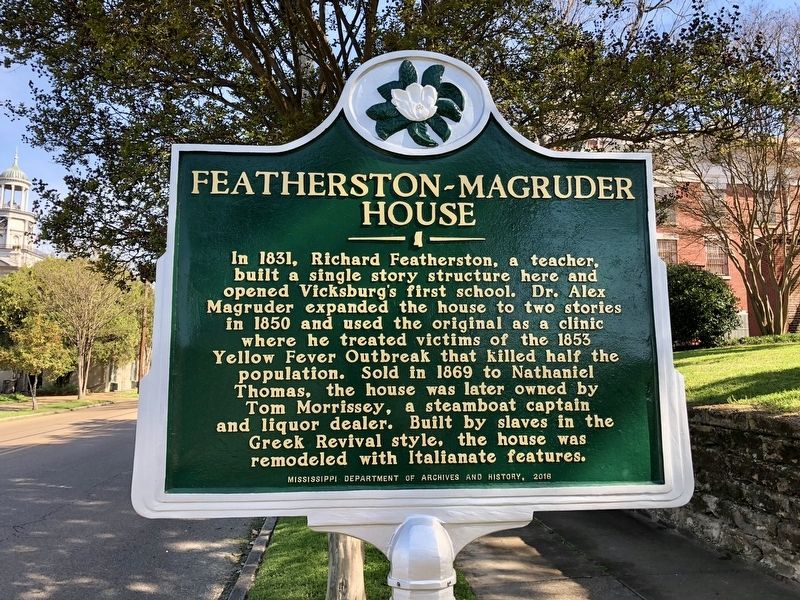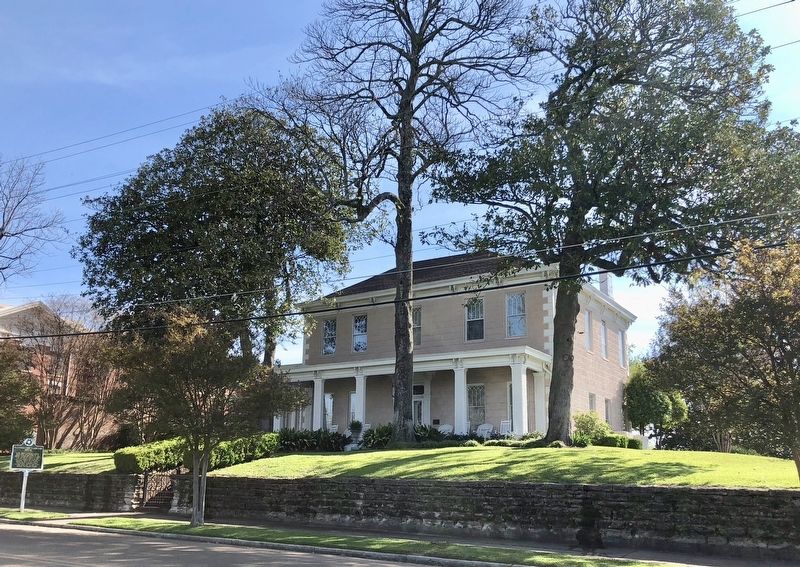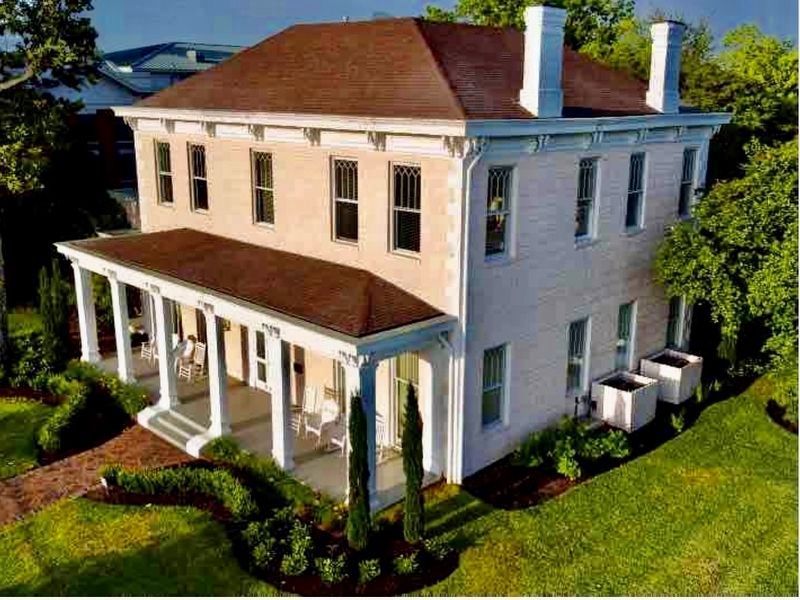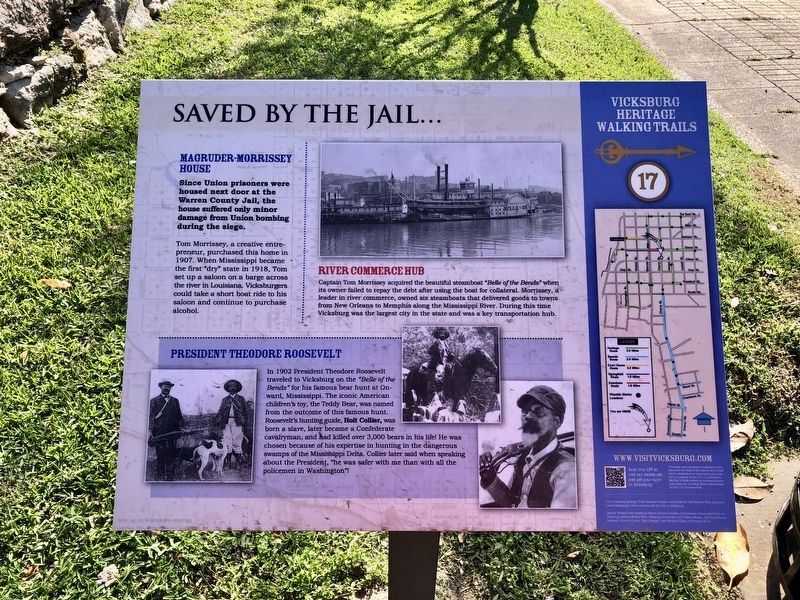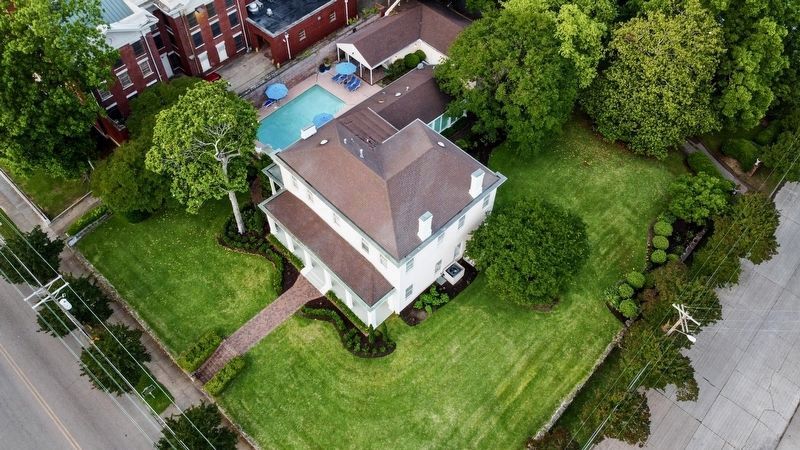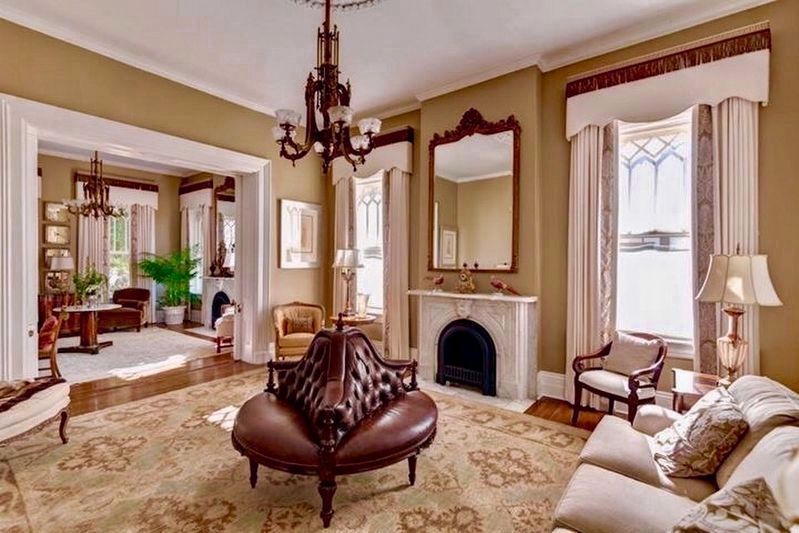Vicksburg in Warren County, Mississippi — The American South (East South Central)
Featherston-Magruder House
Erected 2016 by the Mississippi Department of Archives and History.
Topics and series. This historical marker is listed in these topic lists: Architecture • Education • Science & Medicine. In addition, it is included in the Mississippi State Historical Marker Program, and the Mississippi, Vicksburg Heritage Walking Trail series lists. A significant historical year for this entry is 1831.
Location. 32° 21.058′ N, 90° 52.696′ W. Marker is in Vicksburg, Mississippi, in Warren County. Marker is on Cherry Street north of China Street, on the right when traveling north. Touch for map. Marker is at or near this postal address: 1117 Cherry St, Vicksburg MS 39183, United States of America. Touch for directions.
Other nearby markers. At least 8 other markers are within walking distance of this marker. Saved by the Jail... (within shouting distance of this marker); Hard Times Square (about 300 feet away, measured in a direct line); Old Natchez District (about 300 feet away); South Central Bell (about 300 feet away); Vicksburg (about 300 feet away); The Daily Citizen (about 400 feet away); Federal Works Agency (about 400 feet away); Men of Kindness (about 500 feet away). Touch for a list and map of all markers in Vicksburg.
Regarding Featherston-Magruder House. This house is part of the Vicksburg Heritage Walking Trail (marker #17).
The home is one of the first Italianate architecture homes in the U.S. and is decorated with period pieces from 1850s.
Additional commentary.
1. History of the home
of historic Vicksburg, the Featherston -Magruder Mansion has more stories behind its walls than years on the earth.
The original house, erected in 1831, was built by Richard Featherston, a planter and schoolteacher, to put his family and the town's first school room all under the same roof. The Featherston family was a perfect example of early American migration and its impact on the South. The Featherston’s first came to Amelia County, Virginia, in 1729 from England, and every generation thereafter moved farther west taking more and more land for each son to preserve the eldest’s original land grant from George the II. By the end of the 18th century, the family was spread across Pennsylvania, Tennessee, Louisiana, Mississippi, Iowa and Texas. The family continued to work together and created a chain of relations that slowly built their lives in the American Colonies.
The entire Featherston family used the Natchez Trace to conduct most of their agriculture trade on the Tennessee and Mississippi rivers. From Featherston’s in Pennsylvania, Tennessee and Iowa came the supply laden river flatboats loaded with all sorts of commodities for sale in Vicksburg and Natchez. The boats would consolidate at the Featherston Plantation north of Natchez before their crews would walk back home on the trace. So much harmony existed in the family that brothers and cousins even spread their homes across the trace from Vicksburg to Nashville to accommodate the trade. One cousin, Winfield Featherston, took up his home in Houston, MS, halfway between his parents in Murfreesboro, Tennessee and his cousins in Vicksburg. The family was so successful, they became main suppliers for the American Revolutionary War.
Richard knew he was a descendant of one of the largest suppliers to the American War for Independence. His family also served in the war of 1812 and the Mexican Wars in 1843. In fact, his cousin, Winfield was elected to the US Congress for Mississippi shortly thereafter and became a Brigadier General for the Confederacy in the American Civil War. Richard would have joined him but unfortunately died in 1848 from Yellow Fever in this house; his wife and children were forced to sell the family plantation, this home and all their slaves and move back with relatives in Holly Springs, MS.
So along came Dr. Alex Magruder who bought the property in 1849. He had recently received his Medical Doctorate (MD) from the University of Pennsylvania and had come back to the family plantation north of Natchez.
He had just married and decided to open the town’s first clinic, which would ultimately lead to the opening of the most well-known hospital in the state run by the Sisters of Mercy on Crawford and Adams. He bought the house from the estate of Richard Featherston and immediately began plans to add on a two-story Greek Revival mansion. He turned the school room into his clinic and kitchen and kept the back of the house for his slave servants.
In 1852, a yellow-fever outbreak wiped out half the population of Vicksburg for which Dr. Magruder said the scourge was being brought in by carpet-bagger Jews
coming to secure agent positions with the booming cotton trade, the biggest Jewish family being Lehman Brothers. Little did he know that one day the largest Synagogue in America would be built right across the street from his house.
Dr. Magruder was the great-great-great-great grandson of Alex Magruder, a Scotsman turned against the English in their civil war which led him to sell himself as an indentured servant to a tobacco farmer in Virginia in 1651 to escape being jailed.
Dr. Magruder the younger, treated many of the victims of yellow fever including that 1852-1853 outbreak. Nearly 2,000 people died within months of each other many of them having been treated at the Magruder House. No one had figured out that the illness was carried by mosquitoes and originated in Africa. Dr. Magruder, looking for a scapegoat, credited the disease to "peddlers" who traveled on boat from New Orleans. Peddlers was a thinly veiled reference to Jews. He identified one such peddler who had sold a dress to a Mrs. Lanier and wrote she died of the "black vomit' from that "Jew peddler." The reality is she had bought the dress in New Orleans and had nothing to do with the disease.
Dr. Magruder moved out of town with all his furniture for the duration of the war the house would be relatively untouched, save for one cannon ball which made its way from a Union Armored Steamship into the parlor and is now being used as a door stop.
Family members had to accommodate Union generals after the fall of Vicksburg for a few weeks in this home. The house had as its back-property line a brick wall behind which stood the largest prison in the region, a place the Confederates used to bring Union prisoners of war from all over the country to wait for a large enough POW swap with the North. The reverse for Confederate POWs happened when the Union occupied the city. The original portion of the wall is now part of the old county jail and the only thing dividing our swimming pool from the criminals, who seem to regularly escape, the latest being an escape in 2016 by a deranged serial killer who chopped up his victims. Thank God for the wall!
The Magruder clan was well-known for its white rule campaigns. In fact, each decade the Magruder’s from across the country would gather and write a report on their activities as a Scottish Clan. The entire family actively worked to restore White Rule in the South following the civil war. Dr. Magruder was no exception. During occupation, he grew so impatient that he refused to live in a town that was now being administered by previous African slaves. He moved his family and practice to Georgia where he is now resting in peace six feet under. Ironically, he sold the house in 1869 to Nathaniel Thomas, the nephew of Union General George Thomas from Virginia, whose brother, Benjamin, lived in Vicksburg. There are many stories about the Thomas’s, which was another divided family in the Civil War. George, known as the Rock of Chickamauga, was one of the most instrumental generals in the war. His brother and nephew were very close to him and he frequently visited them at this house before he died in 1870.
The house changed hands again in 1900 when Ms. Regina Hirsch, the wife of a prominent lawyer, bought it. She sold it to Capitan Thomas M. Morrissey in 1909. He was president of the Morrissey-Easton Tractor Co. one of the biggest benefactors of the Cotton Gin, and operator of the steamship Belle of the Bends. The Morrissey’s were well known businessmen in Vicksburg and often plied goods between Louisiana and Mississippi. During prohibition, Louisianans along the Mississippi river refused to take part in the 18th amendment and kept drinking and making bootleg liquor. Capitan Morrissey assisted the process called "rumrunning" with his steamship and self-made one-man submarines. It was rumored that there was a tunnel from this house to the county jail where the police would recirculate the confiscated alcohol back to the Morrissey family who would resell it on the black market. We have never found any evidence of this "tunnel".
The house fell into state of disrepair after the Morrissey’s sold it in 1949 until 1984 when the Cameron family bought it and restored all the original fixtures and fittings. The gas chandeliers and ceiling medallions made from horsehair and plaster as well as the massive gilded mirror are all original. The sold walnut panel doors are also original. The porch in the back was sealed in and the Cyprus wooden floors were restored and replaced. The restoration was aimed at preserving the homes original state but building modern facilities that would make it more of a home than museum.
— Submitted February 6, 2022, by John Wright of Vicksburg, Mississippi.
Credits. This page was last revised on February 7, 2022. It was originally submitted on March 23, 2018, by Mark Hilton of Montgomery, Alabama. This page has been viewed 981 times since then and 77 times this year. Last updated on February 6, 2022, by John Wright of Vicksburg, Mississippi. Photos: 1, 2. submitted on March 23, 2018, by Mark Hilton of Montgomery, Alabama. 3. submitted on February 6, 2022, by John Wright of Vicksburg, Mississippi. 4. submitted on March 23, 2018, by Mark Hilton of Montgomery, Alabama. 5, 6. submitted on February 6, 2022, by John Wright of Vicksburg, Mississippi.
